Taalaibek D. Omurov
Doctor of Physics and Mathematics, professor of Z. Balasagyn Kyrgyz National University, Bishkek, Kyrgyzstan
Correspondence to: Taalaibek D. Omurov , Doctor of Physics and Mathematics, professor of Z. Balasagyn Kyrgyz National University, Bishkek, Kyrgyzstan.
| Email: |  |
Copyright © 2014 Scientific & Academic Publishing. All Rights Reserved.
Abstract
One of the present problems in mathematics is the Navier-Stokes equation, which describes the motion of viscous Newtonian fluid and which is a basic of a hydrodynamics [1]. Therefore in this work we solve a nonstationary problem Navier-Stokes for incompressible fluid with viscosity.
Keywords:
Navier-Stokes, Problem, Incompressible, Conditional-smooth, Solution, Fluid, Flow, Viscosity, Convective the acceleration, Algorithm, Newton’s potential, Limiting, Hypothesis, Beale-Kato-Majda
Cite this paper: Taalaibek D. Omurov , The Methods of a Problem Decision Navier-Stokes for the Incompressible Fluid with Viscosity, American Journal of Fluid Dynamics, Vol. 4 No. 1, 2014, pp. 16-48. doi: 10.5923/j.ajfd.20140401.03.
1. Introduction
If to designate components of vectors of speed and external force, as  that corresponding problem Navier-Stokes is represented in a kind
that corresponding problem Navier-Stokes is represented in a kind | (1.1) |
 | (1.2) |
 | (1.3) |
 is kinematic viscosity,
is kinematic viscosity,  is density,
is density,  is Laplace operator. The additional equation is the condition incompressibility fluid (1.2). Unknown are speed
is Laplace operator. The additional equation is the condition incompressibility fluid (1.2). Unknown are speed  and pressure P.The decision of many problems of theoretical and mathematical physics leads to use of various special weight space. In works [7, 8] for the first time have offered a method which gives solution of problem Navier-Stokes in
and pressure P.The decision of many problems of theoretical and mathematical physics leads to use of various special weight space. In works [7, 8] for the first time have offered a method which gives solution of problem Navier-Stokes in  . To answer the brought attention to the question, we offer the following method of the decision of a problem Navier-Stokes. For this purpose (1.1) we will transform to a kind
. To answer the brought attention to the question, we offer the following method of the decision of a problem Navier-Stokes. For this purpose (1.1) we will transform to a kind  | (1.4) |
 | (1.5) |
where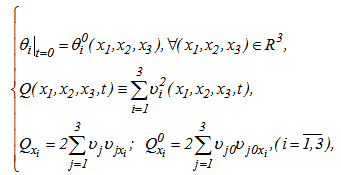 without breaking equivalence of system (1.1) and (1.4), (1.5). The received systems (1.4), (1.5) contain unknown functions
without breaking equivalence of system (1.1) and (1.4), (1.5). The received systems (1.4), (1.5) contain unknown functions  ,
,  and pressure P. Here
and pressure P. Here  - known functions because are known
- known functions because are known  .The developed method of the decision of systems (1.4) and (1.5), is connected with functions
.The developed method of the decision of systems (1.4) and (1.5), is connected with functions  , i.e.A1)
, i.e.A1)  or А2)
or А2)  orА3)
orА3)  is any functions if, accordingly, as necessary conditions, take place: а01)
is any functions if, accordingly, as necessary conditions, take place: а01)  а02)
а02)  а03)
а03)  is any functions. The work purpose. The main object of this work the proof - existence and singleness the problem decision Navier-Stokes for an incompressible fluid with viscosity in cases (А1)-(А3). Theoretical and practical value. The Received decisionson the basis of the developed analytical methods proves in the general applicability of the equations of Navier-Stokes. Thus it is proved that the system (1.1) has the single decision in cases (A1)-(А3). The received results prove to legality of the requirement [1]. Remarks: 1. The Beale-Kato-Majda regularity criterion, originally derived for solutions to the 3D Euler equations [2] and holds for solutions to the 3D equations Navier-Stokes [5] and at that is proved an inequality of a criterion Beale-Kato-Majda [5] for an this problem, and the criterion can be viewed as a continuation principle for strong solutions. A further generalization was presented in [7] where the regularity condition is expressed in terms of the time integrability. Let’s note that there are several criteria of a priori estimates. For instance, it is sufficient to prove an estimate [5]
is any functions. The work purpose. The main object of this work the proof - existence and singleness the problem decision Navier-Stokes for an incompressible fluid with viscosity in cases (А1)-(А3). Theoretical and practical value. The Received decisionson the basis of the developed analytical methods proves in the general applicability of the equations of Navier-Stokes. Thus it is proved that the system (1.1) has the single decision in cases (A1)-(А3). The received results prove to legality of the requirement [1]. Remarks: 1. The Beale-Kato-Majda regularity criterion, originally derived for solutions to the 3D Euler equations [2] and holds for solutions to the 3D equations Navier-Stokes [5] and at that is proved an inequality of a criterion Beale-Kato-Majda [5] for an this problem, and the criterion can be viewed as a continuation principle for strong solutions. A further generalization was presented in [7] where the regularity condition is expressed in terms of the time integrability. Let’s note that there are several criteria of a priori estimates. For instance, it is sufficient to prove an estimate [5] | (1.6) |
where М is a constant as (1.6) for the proof aforesaid the statement.2. In a case  the current is considered with very small viscosity, i.e. in viscous liquids, when force a friction a very small, than forces of inertia [9, 10]. Here Reynolds's number is very great
the current is considered with very small viscosity, i.e. in viscous liquids, when force a friction a very small, than forces of inertia [9, 10]. Here Reynolds's number is very great  there is an border layer in which viscosity influence is concentrated. Therefore the analytical methods giving the decisions of a problem Navier-Stokes allow to reach full understanding of physics of turbulence [3, 4, 9, 10]. And in a case
there is an border layer in which viscosity influence is concentrated. Therefore the analytical methods giving the decisions of a problem Navier-Stokes allow to reach full understanding of physics of turbulence [3, 4, 9, 10]. And in a case  the current is considered with average size of viscosity [10]. Therefore in a case when convective acceleration is not equal to zero problems connected with methods of integration of the equations of Navier-Stokes in their general view are arisen. Our problem does not include a derivation of an equation in a physical meaning, since there is a big amount of works reflecting these questions [3, 4, 6, 9-11].
the current is considered with average size of viscosity [10]. Therefore in a case when convective acceleration is not equal to zero problems connected with methods of integration of the equations of Navier-Stokes in their general view are arisen. Our problem does not include a derivation of an equation in a physical meaning, since there is a big amount of works reflecting these questions [3, 4, 6, 9-11].
2. Problem Navier-Stokes for Fluid with a Condition (A1)
In this paragraph in the subsequent points, at the specified restrictions on the entrance data, the strict substantiation of compatibility of systems (1.4), (1.5) will be given with very small viscosity  .
.
2.1. Research with a Condition (A1)
Let functions  satisfy to a condition (a01). Then relatively
satisfy to a condition (a01). Then relatively  we suppose a condition (A1) and
we suppose a condition (A1) and | (2.1) |
where from system (1.4) and (1.5), accordingly we will receive following systems | (2.2) |
 | (2.3) |
Theorem 1. Let conditions (1.2), (1.3), (A1) and (2.1) are satisfied. Then systems (2.2) and (2.3) it is equivalent will be transformed to a kind | (2.4) |
Hence, the problem (1.1) - (1.3) has the unique decision which satisfies to a condition (1.2).Proof. From system (2.2) it is visible, if the 1-equation (2.2, i=1) it is differentiated on x1, 2-equation on x2 (2.2, i=2), 3-equation on x3 (2.2, i=3), and it is summarised from here we will receive the equation of Puasson [11]
from here we will receive the equation of Puasson [11]  | (2.5) |
as | (2.6) |
At that it is proved | (2.7) |
Algorithm when we will receive the equation of Puasson (2.5) for brevity we name «algorithm puassonization systems».In work of Sobolev [11] it is specified that function (2.7) satisfies to the equation (2.5) and is called Newton’s potential. Therefore, if J - the decision of the equation (2.5), then substituting  | (2.8) |
in (2.2), we have | (2.9) |
i.e. system (2.2) it is equivalent by (2.9) will be transformed to a kind linear the nonuniform equation of heat conductivity. Here the equations (2.5), (2.9) is there are first and second equations of system (2.4). From system (2.9), follows [7]: | (2.10) |
All  - is known functions and
- is known functions and  are defined from system (2.10)
are defined from system (2.10) | (2.11) |
Then, on the basis of (2.3), (2.10) and (2.11), and their private derivatives on xi, we find | (2.12) |
As  - is known functions, hence from system (2.12) differentiating 1 equation on x1 [(2.12): i=1], 2 equations on х2 [(2.12): i=2], 3 equations on х3 [(2.12): i=3], and summarising, we will receive
- is known functions, hence from system (2.12) differentiating 1 equation on x1 [(2.12): i=1], 2 equations on х2 [(2.12): i=2], 3 equations on х3 [(2.12): i=3], and summarising, we will receive | (2.13) |
at that  The equation (2.13) is the third equation of system (2.4). Therefore, from the received results, taking into account (2.7), follows
The equation (2.13) is the third equation of system (2.4). Therefore, from the received results, taking into account (2.7), follows | (2.14) |
i.e. functions  are defined from systems (2.10), (2.13), (2.14), where (2.14) - the equation of type of Bernoulli.Singleness is obvious, as a method by contradiction from (2.10) singleness of the decision follows
are defined from systems (2.10), (2.13), (2.14), where (2.14) - the equation of type of Bernoulli.Singleness is obvious, as a method by contradiction from (2.10) singleness of the decision follows . Results (2.10) with a condition ((A1), (2.1)) are received where smoothness of functions is required only on xi as the derivative of 1st order is in time has t>0. Then taking into account (2.10), (2.13), (2.14) and the system (2.4) has the single continuous decision.Further, considering private derivatives of 1st order
. Results (2.10) with a condition ((A1), (2.1)) are received where smoothness of functions is required only on xi as the derivative of 1st order is in time has t>0. Then taking into account (2.10), (2.13), (2.14) and the system (2.4) has the single continuous decision.Further, considering private derivatives of 1st order | (2.15) |
and summarising (2.15) with taking into account (1.2), we have as
as  . Means, the system (2.10) satisfies to the equation (1.2).
. Means, the system (2.10) satisfies to the equation (1.2).
2.2. Limitation of Functions  in
in  or
or 
I. The limiting case which we will consider concerns results of the theorem 1. Then the decision of system (1.1) is representing in the form of (2.10) with conditions (1.2), (1.3), (A1), (2.1) and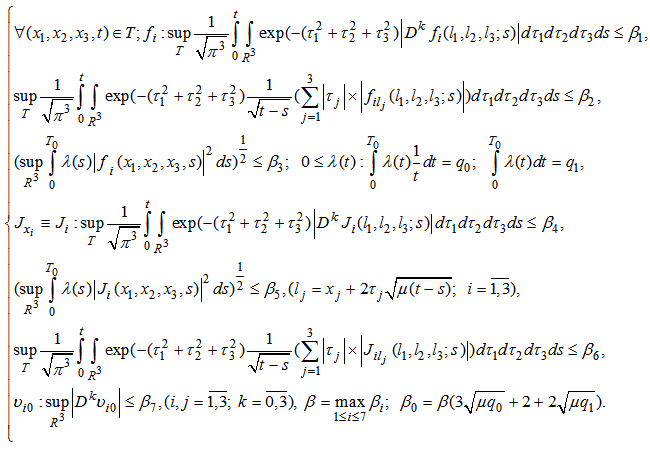 | (2.16) |
Really, estimating (2.10) in  , we have [7]:
, we have [7]: 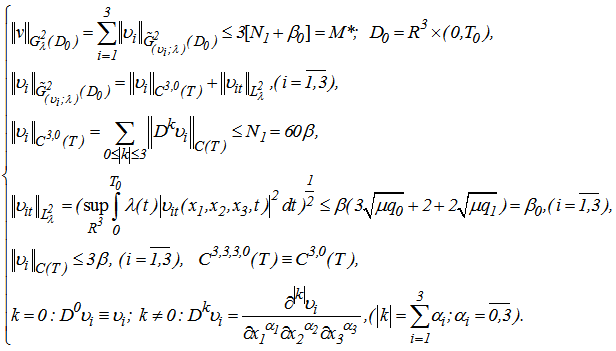 | (2.17) |
Theorem 2. In the conditions of the theorem 1 and (2.16), (2.17) the problem (1.1) - (1.3) has the single decision in .II. Alternatively, we can consider, e.g., a class of suitable solutions constructed in
.II. Alternatively, we can consider, e.g., a class of suitable solutions constructed in  As
As  , the decision of problem Navier-Stokes (1.1) - (1.3) belongs in
, the decision of problem Navier-Stokes (1.1) - (1.3) belongs in  . Then on the basis of lemma K. Friedrichs [13], it is the decision and belongs to space of weight
. Then on the basis of lemma K. Friedrichs [13], it is the decision and belongs to space of weight 
 where
where The limiting case which we will consider concerns results of the theorem 1. Then the decision of system (1.1) is representing in the form of (2.10). Then estimating (2.10) in
The limiting case which we will consider concerns results of the theorem 1. Then the decision of system (1.1) is representing in the form of (2.10). Then estimating (2.10) in  , we have
, we have | (2.18) |
i.e. in the conditions of (1.2), (1.3), (А1) and (2.16), (2.18) the problem (1.1) - (1.3) has a single decision in  . Remarks: 1. From the received results follows that on the basis of the developed methods of equation Navier-Stokes it is led to the linear equations of a kind of heat conductivity with a condition of Koshi and for
. Remarks: 1. From the received results follows that on the basis of the developed methods of equation Navier-Stokes it is led to the linear equations of a kind of heat conductivity with a condition of Koshi and for  in a class of the limited functions with smooth enough initial data at
in a class of the limited functions with smooth enough initial data at  is correctly put [11, 12]. Accordingly there is a unique, is conditional-smooth decision of problem Navier-Stokes in
is correctly put [11, 12]. Accordingly there is a unique, is conditional-smooth decision of problem Navier-Stokes in  or
or  2. Definition 1. The generalised decision a problems (1.1)-(1.3), (A1) in area
2. Definition 1. The generalised decision a problems (1.1)-(1.3), (A1) in area  we name any continuous in
we name any continuous in  equation decision (2.10). Therefore, the nonstationary problem of Navier-Stokes (1.1) - (1.3) has the single decision.If the problem (1.1) - (1.3), (А1) has the exact classical decision the generalised decision coincides with it [11].
equation decision (2.10). Therefore, the nonstationary problem of Navier-Stokes (1.1) - (1.3) has the single decision.If the problem (1.1) - (1.3), (А1) has the exact classical decision the generalised decision coincides with it [11].
2.3. Inequality Beale-Kato-Majda
Inequality Beale-Kato-Majda. The criterion can be viewed as a continuation principle for strong solutions. On the basis of results of the theorem 1 the of decision a systems (1.1) it is presented in of a kind (2.10), where global existence of decisions is received in a class  (or
(or  ) from the point of view of the initial data satisfying (2.10). It is pleasant that results of this theorem leads to such global classical decision Navier-Stokes, besides it is known that in [5] classical decision is received, if the criterion of Beale-Kato-Majda is executed. There are several criteria of a priori estimates. For instance, it is sufficient to prove an estimate (1.6). Really at performance of conditions of the theorem 1 takes place
) from the point of view of the initial data satisfying (2.10). It is pleasant that results of this theorem leads to such global classical decision Navier-Stokes, besides it is known that in [5] classical decision is received, if the criterion of Beale-Kato-Majda is executed. There are several criteria of a priori estimates. For instance, it is sufficient to prove an estimate (1.6). Really at performance of conditions of the theorem 1 takes place  Therefore we will receive an estimation of type Beale-Kato-Majda
Therefore we will receive an estimation of type Beale-Kato-Majda | (2.19) |
Let's note that the similar inequality turns out and in  Really in conditions, when the decision of system (2.10) belongs in we will receive
Really in conditions, when the decision of system (2.10) belongs in we will receive | (2.20) |
3. Fluid with Average Viscosity with a Condition (A2)
Area of the fluid with average viscosity where all inertial members contain in the equations of Navier-Stokes theoretically it is not investigated till now [10]. The decision method, from where follows of equations integration of Navier-Stokes in a case (А2), is a major factor of this point. The developed method of the decision of system (1.1) is connected with  where these functions will transform (1.1) to systems (1.4), (1.5) with conditions (а02) and
where these functions will transform (1.1) to systems (1.4), (1.5) with conditions (а02) and | (1.3)* |
 | (3.1) |
where the current is considered with average size of viscosity.Theorem 3. Systems (1.4), (1.5) it is equivalent will be transformed to a kind  | (3.2) |
when conditions (1.2), (1.3)*, (3.1), (А2) are satisfied. Hence, the nonstationary problem of Navier-Stokes (1.1)-(1.3)* has the single continuous decision.Proof. Really, from system (1.4), considering conditions (1.2), (1.3)*, (3.1) and having entered «algorithm puassonization systems», i.e. differentiating the equations of system (1.4) accordingly on хi and, then summarising, we have the equation  | (3.3) |
If  - the decision of the equation (3.3), then substituting
- the decision of the equation (3.3), then substituting  in system (1.4), we have
in system (1.4), we have | (3.4) |
The decision of a problem (1.1)-(1.3)* is represented in a kind | (3.5) |
where concerning functions  , we will receive
, we will receive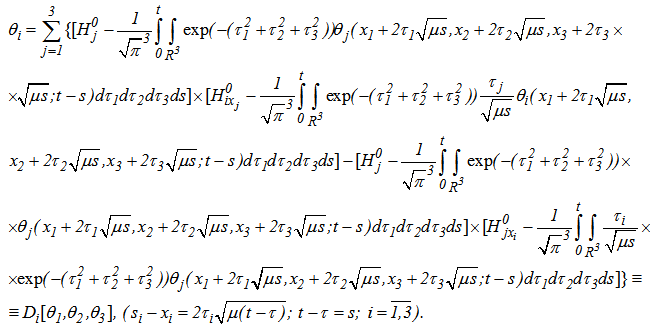 | (3.6) |
Here for example, private derivatives of functions  are defined:
are defined: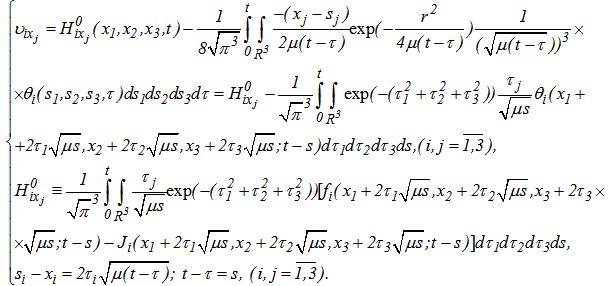 | (3.7) |
Here (3.6) – system of the nonlinear integrated equations of Volterr-Abel of the second sort concerning  on a variable t.Therefore, if operators:
on a variable t.Therefore, if operators:  compressing with a compression factor
compressing with a compression factor  ,
,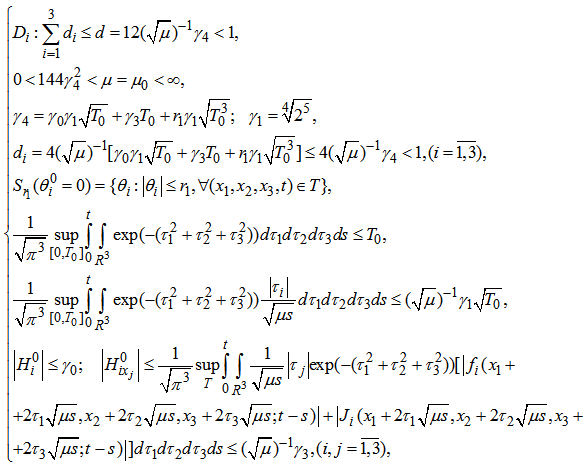 | (3.8) |
then the system (3.6) is solvable at  . Hence the solution of this system we can find on the basis of Picard’s method:
. Hence the solution of this system we can find on the basis of Picard’s method:  where
where  initial estimates. Thus we will receive
initial estimates. Thus we will receive | (3.9) |
Then according to results of the theorem 3, functions  are defined from system (3.5)
are defined from system (3.5)  | (3.5)* |
here  - known functions and
- known functions and 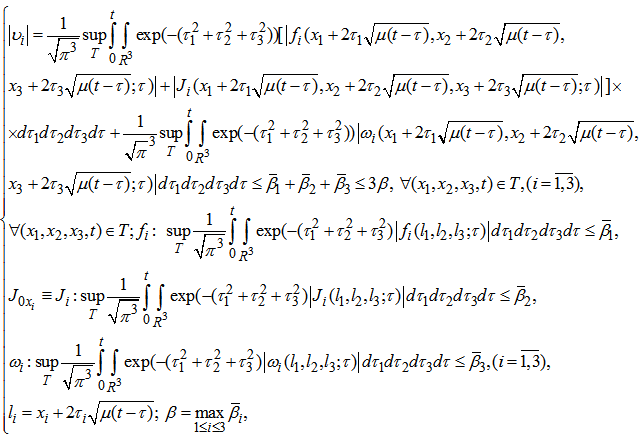 i.e.
i.e.  Thus the equation (3.5) * satisfies conditions (1.2).Really considering private derivatives of 1st order the equations (3.5)* and summing, we have:
Thus the equation (3.5) * satisfies conditions (1.2).Really considering private derivatives of 1st order the equations (3.5)* and summing, we have:  as
as  From the received results, on the basis of (3.3) follows
From the received results, on the basis of (3.3) follows | (3.10) |
Then according to results of the theorem 3, functions  are defined from system (3.5)* and satisfies the equation (1.2). The theorem is proved.Remark 1. For a problem Navier-Stokes (1.1)-(1.3)*, (A2), are proved: existence and singleness of the decision in the field of
are defined from system (3.5)* and satisfies the equation (1.2). The theorem is proved.Remark 1. For a problem Navier-Stokes (1.1)-(1.3)*, (A2), are proved: existence and singleness of the decision in the field of  , and we will notice that the received decision (3.5)* continuously depends on the initial data.Let's notice that the generalised decision a problems (1.1)-(1.3)*, (A2) in area
, and we will notice that the received decision (3.5)* continuously depends on the initial data.Let's notice that the generalised decision a problems (1.1)-(1.3)*, (A2) in area  we name any continuous in
we name any continuous in  equation decision (3.5)*, when
equation decision (3.5)*, when  As the problem (1.1)-(1.3)*, (A2) has the single usual decision the generalised decision coincides with this decision [11].
As the problem (1.1)-(1.3)*, (A2) has the single usual decision the generalised decision coincides with this decision [11].
4. Fluid with Very Small Viscosity with a Condition (A3)
From the received results of this point follows that system Navier-Stokes (1.1) in the conditions of (1.2), (1.3), (A3) can have the analytical unique, is conditional-smooth decision. At least, such decision answers a mathematical question, and possibility to construct the decision on a problem Navier-Stokes (1.1)-(1.3) for an incompressible liquid with viscosity with a condition (А3).
4.1. Fluid with Viscosity with a Condition (A3)
I. Let  initial components of a vector of speed
initial components of a vector of speed  at the moment of time
at the moment of time  it is set in a kind (1.3):
it is set in a kind (1.3): | (4.1) |
where  known constants. Then speed components
known constants. Then speed components  are defined by a rule
are defined by a rule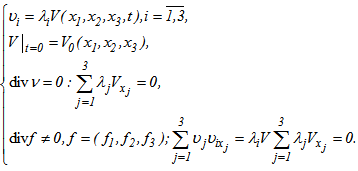 | (4.2) |
Hence, the system (1.1) will be transformed to a kind | (4.3) |
where  new unknown function which defines the decision on problem Navier-Stokes. Here substitution (4.2) it is equivalent will transform system (1.1) to the linear nonuniform equation of heat conductivity of a kind (4.3).From system (4.3), considering conditions (4.1), (4.2), and having entered «algorithm puassonization systems», i.e. differentiating the equations of system (4.3) accordingly on хi and, then summarising, we have the equation
new unknown function which defines the decision on problem Navier-Stokes. Here substitution (4.2) it is equivalent will transform system (1.1) to the linear nonuniform equation of heat conductivity of a kind (4.3).From system (4.3), considering conditions (4.1), (4.2), and having entered «algorithm puassonization systems», i.e. differentiating the equations of system (4.3) accordingly on хi and, then summarising, we have the equation | (4.4) |
Then the decision of a problem (4.2), (4.3) is represented in a kind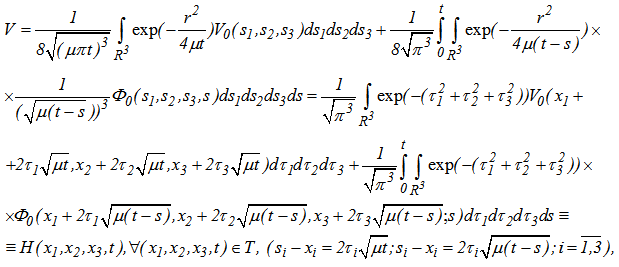 | (4.5) |
here  - known function and
- known function and | (4.6) |
From the received results follows that functions  are defined on the basis of (4.2), i.e.
are defined on the basis of (4.2), i.e. | (4.7) |
Remark 2. Further, considering private derivatives of 1st order systems (4.7) and summing up with acceptance in attention (1.2), (4.2) we have, that the system (4.7) satisfies to a condition (1.2). II. Let's notice that, as  , the decision of problem Navier-Stokes (1.1), (1.2), (4.1) belongs in
, the decision of problem Navier-Stokes (1.1), (1.2), (4.1) belongs in  For this purpose it is enough to show function accessories
For this purpose it is enough to show function accessories  in
in 
 | (4.8) |
Really, if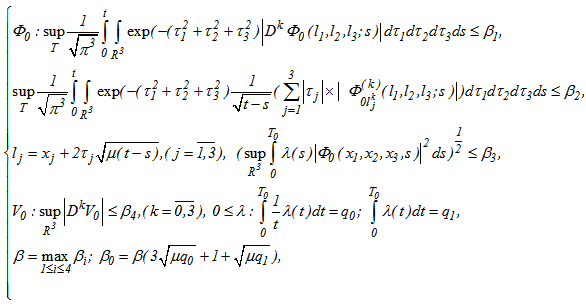 | (4.9) |
that | (4.10) |
Therefore in the conditions of (4.2), (4.6) and (4.9) the equation (4.5) has a single decision in  Theorem 4. In the conditions of (1.2), (4.1), (А3), (4.2), (4.6) and (4.9) the problem (1.1), (1.2), (4.1) has a single decision in
Theorem 4. In the conditions of (1.2), (4.1), (А3), (4.2), (4.6) and (4.9) the problem (1.1), (1.2), (4.1) has a single decision in  , which is defined by a rule (4.7). Remark 3. At performance of conditions of remark 2 and
, which is defined by a rule (4.7). Remark 3. At performance of conditions of remark 2 and 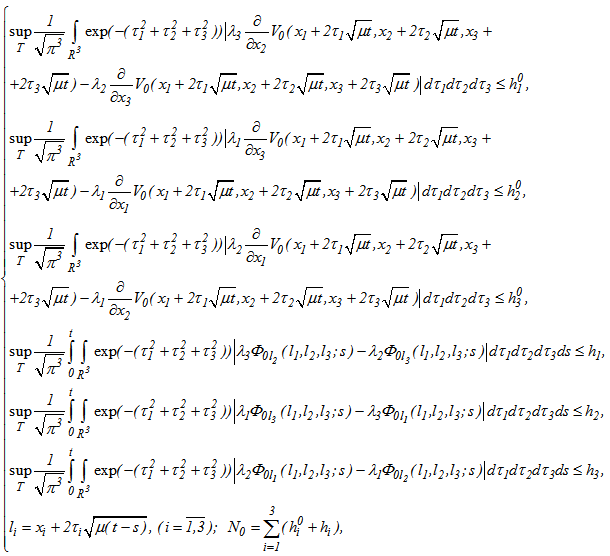 takes place
takes place | (4.11) |
And in a case  , we will receive a inequality
, we will receive a inequality  i.e. we will receive an estimation of type Beale-Kato-Majda [2, 5].
i.e. we will receive an estimation of type Beale-Kato-Majda [2, 5].
4.2. Modified Variant of a Method (4.2) with the Condition (A3), When 
Here we will show that at certain mathematical transformations of the equation Navier-Stokes is led to a linear kind. Thus once again visually confirming [10], i.e. that really equations Navier-Stokes in a case of very small viscosity will have of the decision the obvious form really turns out. Let's consider updating of the basic method §4.2: (4.2). Here we will see that components of speed the more any, than in rules (4.2). Therefore in this case the problem (1.1) - (1.3) does not contain in itself restriction in kinds (А1), (А2). And in it urgency of research in a case (А3) consists. Let’s for incompressible streams with a friction with a condition (А3) also it is prospective  | (4.12) |
Then functions  is represented in a kind
is represented in a kind  | (4.13) |
where  known constants. Further, supposing (4.12), (4.13) and
known constants. Further, supposing (4.12), (4.13) and  | (4.14) |
Then for incompressible currents with a friction the equations of Navier-Stokes (1.1) become simpler as take place (4.12)-(4.14). Therefore the problem (1.1)-(1.3), is led to a kind | (4.15) |
From system (4.15), considering conditions (4.12)-(4.14) and having entered «algorithm puassonization systems», i.e. differentiating the equations of system (4.15) accordingly on  and, then summarising, we have the equation:
and, then summarising, we have the equation:  | (4.16) |
as takes place 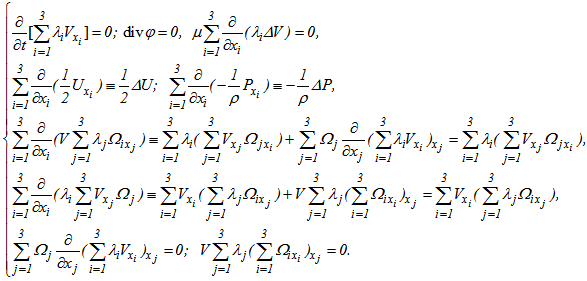 Then on a basis (4.16) system (4.15) it is equivalent, will be transformed to a kind:
Then on a basis (4.16) system (4.15) it is equivalent, will be transformed to a kind: | (4.17) |
or from (4.17), follows: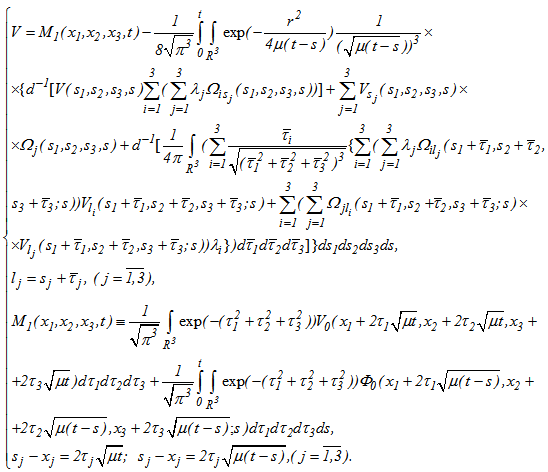 | (4.18) |
Further, differentiating (4.18) on  and having entered designations
and having entered designations  | (4.19) |
from (4.18) we will receive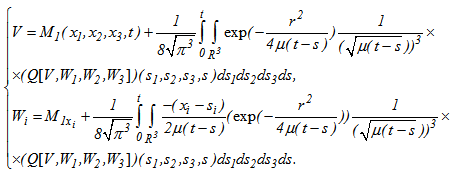 | (4.20) |
Or we will transform (4.20) to a kind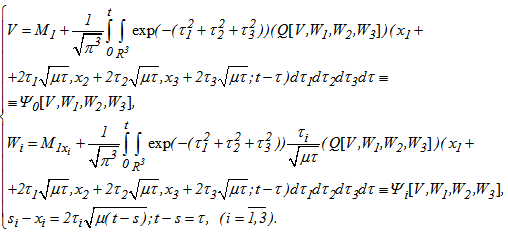 | (4.21) |
Here (4.21) – system of the nonlinear integrated equations of Volterr-Abel of the second sort concerning  on a variable t. Therefore, if takes place:
on a variable t. Therefore, if takes place: 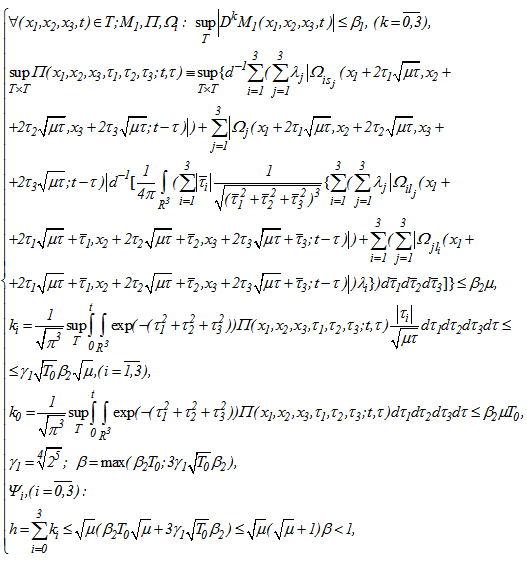 | (4.22) |
that on a basis (4.22) and (4.21) it is had  i.e.:
i.e.:  | (4.23) |
Therefore the solution of this system we can find on the basis of Pikard’s method | (4.24) |
at that  | (4.25) |
From here follows | (4.26) |
Theorem 5. Under conditions (1.2), (1.3), (A3), (4.12), (4.13), (4.22), (4.26) problem Navier-Stokes has the single decision in  in a kind:
in a kind: | (4.27) |
Remarks:I. If takes place  that
that  In a case
In a case  then
then  | (4.28) |
Let's note, as (4.22) Concerns is to the equations of Volterr-Abel on a variable  , discussing in language of the Volterrov equations we can find the decision. But such way from the practical point of view when
, discussing in language of the Volterrov equations we can find the decision. But such way from the practical point of view when  it is not applicable. Therefore, an offered variant more universal in sense of the theory of operators [11, 12]. II. From the received results follows that a problem Navier-Stokes (1.1)-(1.3) in a case (4.12), (A3) with smooth enough initial data has the conditional-smooth and single decision in a kind (4.27).
it is not applicable. Therefore, an offered variant more universal in sense of the theory of operators [11, 12]. II. From the received results follows that a problem Navier-Stokes (1.1)-(1.3) in a case (4.12), (A3) with smooth enough initial data has the conditional-smooth and single decision in a kind (4.27).
4.3. Method (4.13), When 
The algorithm (4.13) also is applicable in a case, if | (4.29) |
That on a basis (4.14) we will receive (4.15). Hence, we have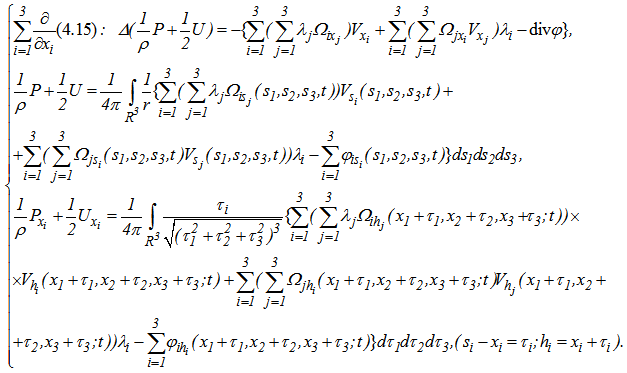 | (4.30) |
Then on a basis (4.30) system (4.15) it is equivalent, will be transformed to a kind: | (4.31) |
or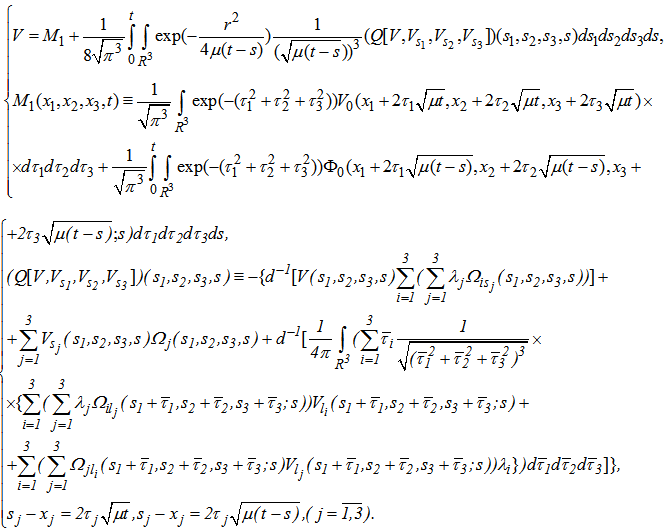 | (4.32) |
Further, differentiating (4.32) on  and having entered designation:
and having entered designation:  from (4.32) we will receive (4.21):
from (4.32) we will receive (4.21):  | (4.33) |
Hence, as takes place (4.22), that the solution of system (4.33) we can find on the basis of Pikard’s method. Then on a basis (4.24), (4.25) we have | (4.34) |
Further, we will receive similar results in the conditions of the theorem 5, i.e. under conditions (1.2), (1.3), (A3), (4.29), (4.34) problem Navier-Stokes has the single decision in  in a kind (4.27).
in a kind (4.27).
4.4. Method (4.13), When 
Results §4.2, §4.3 it is modified in a case when condtions: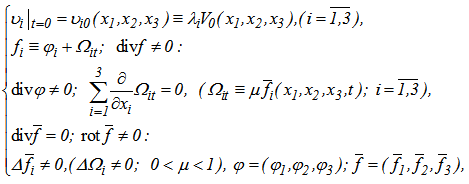 | (4.35) |
are satisfied. Then considering results §4.2, §4.3 we will receive similar conclusions of theorems 5, accordingly.Allow a condition (4.35) it is satisfied. Then from (4.13) follows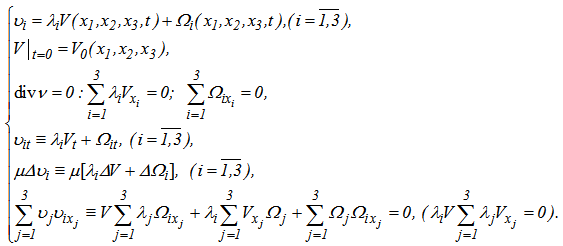 | (4.36) |
Therefore from system (1.1) follows  | (4.37) |
From system (4.37), considering conditions (4.35), (4.36) and having entered «algorithm puassonization systems», as a result we will receive 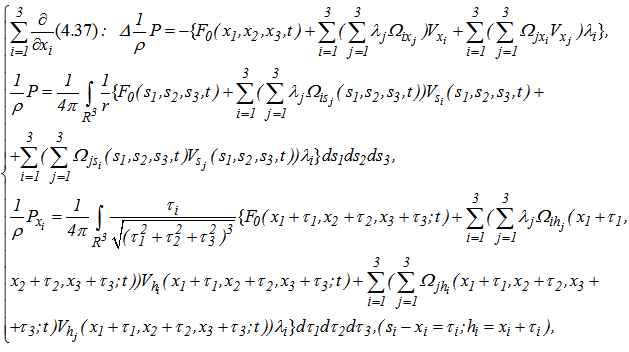 | (4.38) |
as takes place  Then on a basis (4.38) system (4.37) it is equivalent, will be transformed to a kind:
Then on a basis (4.38) system (4.37) it is equivalent, will be transformed to a kind: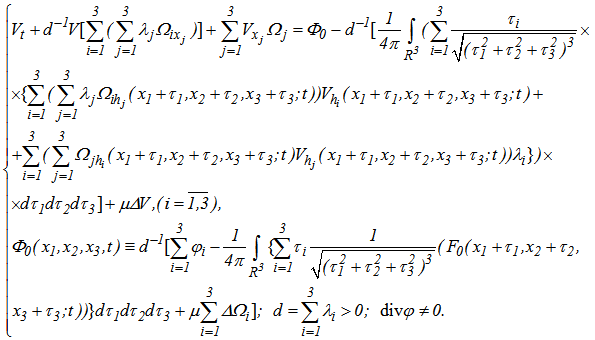 | (4.39) |
Hence 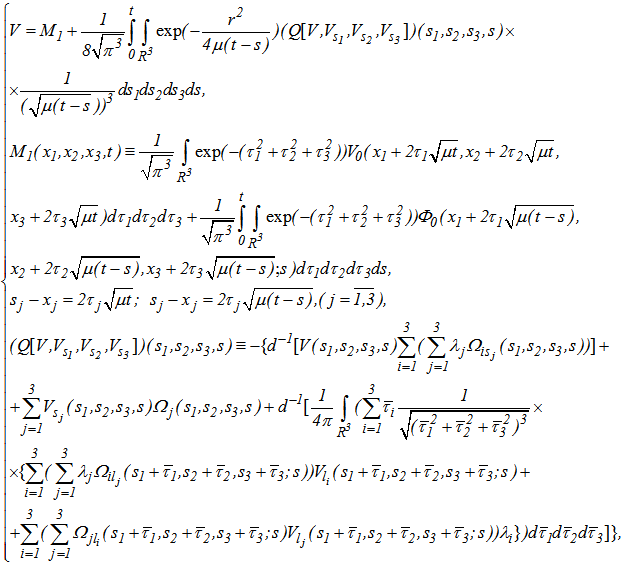 or
or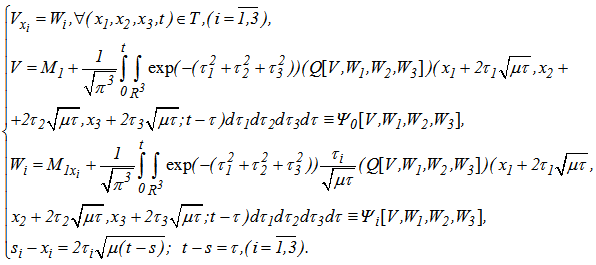 | (4.40) |
If concerning system (4.40) takes place (4.22), that the solution of system (4.40) we can find on the basis of Pkard’s method  | (4.41) |
Further, we will receive similar results in the conditions of the theorem 5. Remark 4. Actually at use of offered transformations occurs linearization of equations Navier-Stokes in the integrated form without the requirement of additional conditions. Thus, the decision of the received integrated equations possesses that and properties, as the decision of initial problems. The received obvious analytical decision is regular concerning viscosity factor  and in many respects simplifies carrying out of the analysis and in mathematical and physical sense. Therefore there is no necessity to copy known results of fundamental works, and it is enough to refer to them.
and in many respects simplifies carrying out of the analysis and in mathematical and physical sense. Therefore there is no necessity to copy known results of fundamental works, and it is enough to refer to them.
5. Problem Navier - Stokes with Average Viscosity with a Condition (A3)
Area of the fluid with average viscosity with condition (A2), when  it is studied in point 3. The decision method, from where follows of equations integration of Navier-Stokes (1.1)-(1.3) in a case (А2), it is not applicable to a problem (1.1) - (1.3) with a condition (А3). Hence, here we will consider a methods of the equations integration of Navier-Stokes with a condition (А3), when:
it is studied in point 3. The decision method, from where follows of equations integration of Navier-Stokes (1.1)-(1.3) in a case (А2), it is not applicable to a problem (1.1) - (1.3) with a condition (А3). Hence, here we will consider a methods of the equations integration of Navier-Stokes with a condition (А3), when: 
5.1. Fluid with Average Viscosity with a Condition (A3)
Therefore, in this case, if the initial data  is set in a kind:
is set in a kind: 
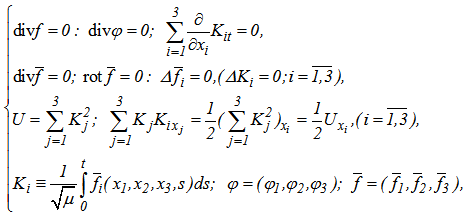 | (5.1) |
we enter for definition a component of speeds:  | (5.2) |
at that | (5.3) |
Then on the basis (5.2), (5.3) we will receive | (5.4) |
Hence on a basis (5.4), we have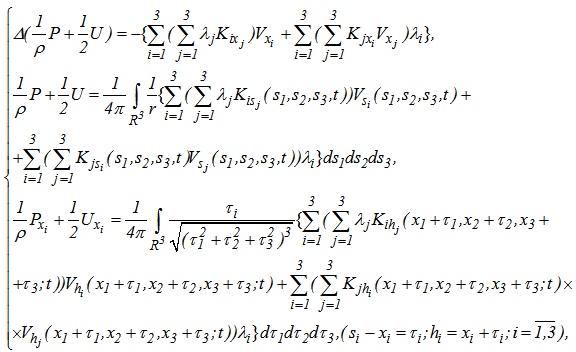 | (5.5) |
as 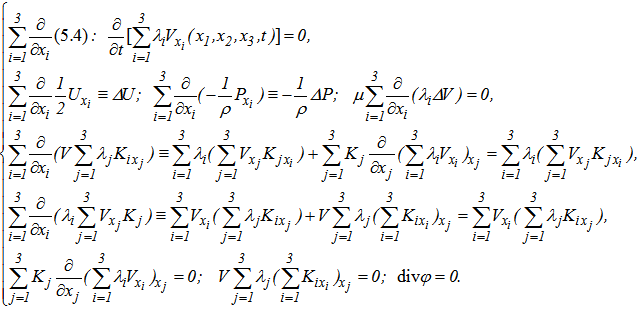 Then system (5.4) it is equivalent will be transformed to a kind
Then system (5.4) it is equivalent will be transformed to a kind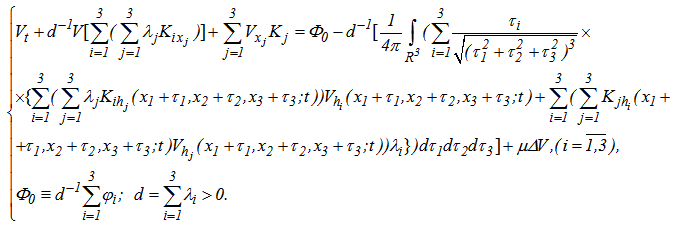 | (5.6) |
Or for consideration of unknown function  we have
we have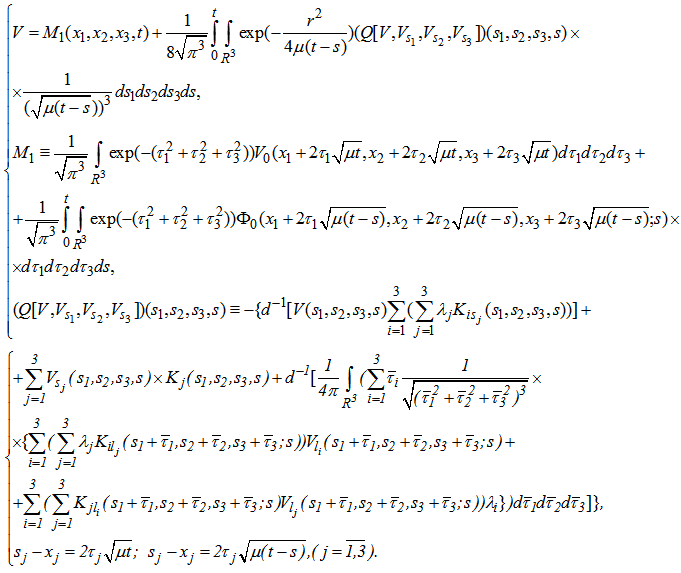 | (5.7) |
Hence, differentiating (5.7) on  and having entered designation:
and having entered designation:  | (5.8) |
from (5.7) we will receive 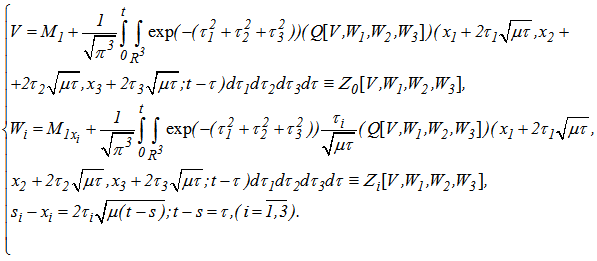 | (5.9) |
If takes place: 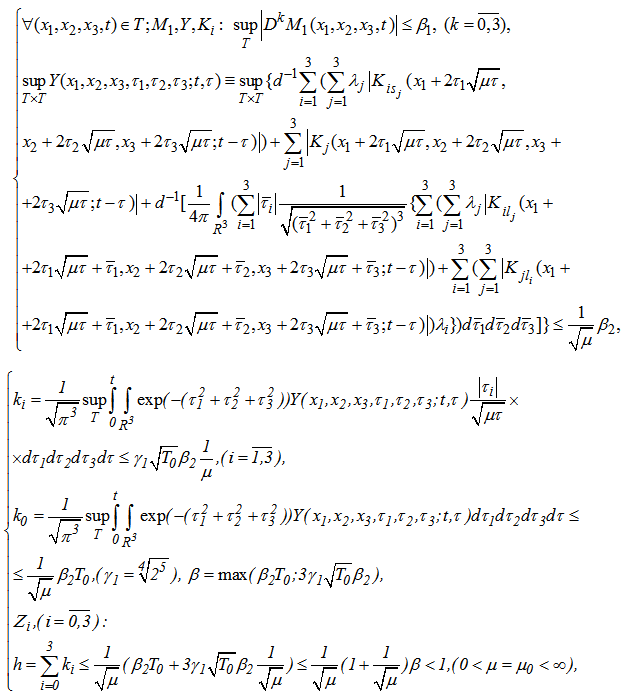 | (5.10) |
that  | (5.11) |
Then the solution of this system we can find on the basis of Pikard’s method | (5.12) |
at that  | (5.13) |
From here follows | (5.14) |
Theorem 6. Under conditions (1.2), (1.3), (A3), (5.1), (5.10) problem Navier-Stokes has the single continuous decision, which it is found by a rule (5.2).Remarks:I. Singleness is obvious, as a method by contradiction. Results (5.14) with a condition ((A3), (5.1), (5.9)) are received where smoothness of functions is required only on xi as the derivative of 1st order is in time has t>0. Then taking into account (5.14) the system (5.9) has the single continuous decision  . II. The algorithm (5.2) also is applicable in a case, if
. II. The algorithm (5.2) also is applicable in a case, if | (5.15) |
That on a basis (5.15), (5.2) we will receive (5.4). Hence, we have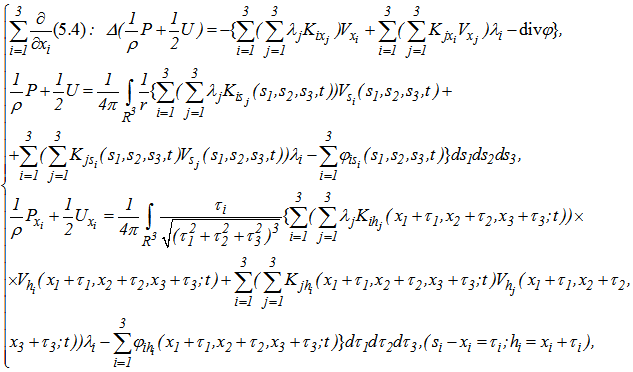 | (5.16) |
here (5.16) differs from (5.5), as  Then considering (5.6)-(5.8) we will receive system (5.9):
Then considering (5.6)-(5.8) we will receive system (5.9): | (5.17) |
Therefore, as takes place (5.10) in a consequence (5.12), (5.13) we will receive  | (5.18) |
Further, we will receive similar results in the conditions of the theorem 6.
5.2. Method (5.2), When 
If the initial data  is set in a kind
is set in a kind  | (5.19) |
that on a basis (5.2) and (5.19), we have | (5.20) |
Then from (1.1) follows  | (5.21) |
Hence on a basis (5.21), we have | (5.22) |
as  Therefore system (5.21) it is equivalent will be transformed to a kind
Therefore system (5.21) it is equivalent will be transformed to a kind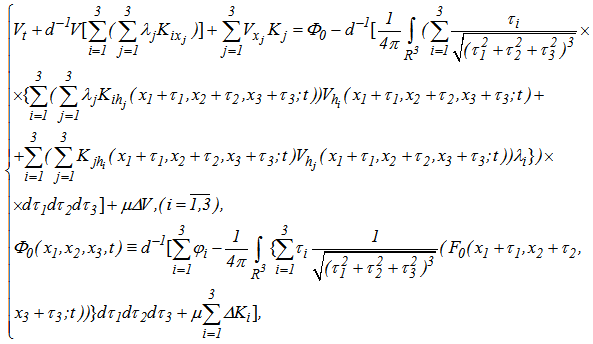 | (5.23) |
where  Or considering (5.7) - (5.9) for of unknown functions
Or considering (5.7) - (5.9) for of unknown functions  we have
we have 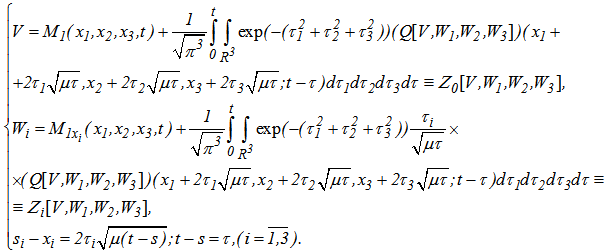 | (5.24) |
Further, at the condition (5.10) in a consequence (5.11)-(5.13) takes place  Hence, we will receive similar results in the conditions of the theorem 6.
Hence, we will receive similar results in the conditions of the theorem 6.
6. Conclusions
1. From the received results follows that system Navier-Stokes (1.1) in the conditions of (1.2), (1.3), (A1)-(A3) can have single analytical is conditional-smooth decision, i.e. we will receive the solution of a millennium problem [1]. At least, such decision answers to a question, and possibility to construct the decision of a problem of Navier-Stokes (1.1)-(1.3) for an incompressible fluid with viscosity [1].2. The received results is analogous to the celebrated Beale-Kato-Majda type criterion for the inviscid equations of incompressible fluids [2, 5]. 3. Results of the theorems 1, 2 and 4 are applicable in a case  . And results of the theorems 3, 5, 6 can be applied to a problem of Navier-Stokes of an incompressible fluid with viscosity, when
. And results of the theorems 3, 5, 6 can be applied to a problem of Navier-Stokes of an incompressible fluid with viscosity, when 
References
| [1] | Navier-Stokes Existence and Smoothness Problem//The Millennium Problems, stated in 2000 by Clay Mathematics Institute. |
| [2] | Beale, J.T., Kato, T., Majda, A. (1984). Remarks on the breakdown of smooth solutions for the 3-D Euler equations, Comm. Math. Phys. 94 (1), pp. 61-66. |
| [3] | Birkhoff, G. (1983). Numerical fluid dynamics. SIAM Rev., Vol.25, No1, pp.1-34. |
| [4] | Cantwell, B.J. (1981). Organized motion in turbulent flow. Ann. Rev. Fluid Mech. Vol.13, pp.457-515. |
| [5] | Grujic, Z., Guberovic, R. (2010). A regularity criterion for the 3D NSE in a local version of the space of functions of bounded mean oscillations, Ann. I. H. Poincare, Anal. Non Lineaire 27, pp. 773-778. |
| [6] | Ladyzhenskya, O.A. (1970), Mathematical questions of dynamics of a viscous incompressible liquid (in Russian). - Moscow: Science, 288 p. |
| [7] | Omurov, T.D. (2013). Nonstationary Navier-Stokes Problem for Incompressible Fluid with Viscosity. American J. Math. & Statistics, Vol. 3, №.6, pp. 349-356. (http://article.sapub.org/10.5923.j.ajms.20130306.08.html) |
| [8] | Omurov, T.D. (2010). Nonstationary Navier-Stokes Problem for Incompressible Fluid. - J.Balasagyn KNU, Bishkek, 21p. [The main content of the work is registered in Kyrgyzpatent, author certificate No.1543 of 2010/07/30] |
| [9] | Prantdl, L. (1961). Gesammelte Abhandlungen zur angewandten Mechanik, Hudro- und Aerodynamic. Springer, Berlin. |
| [10] | Schlichting’s, H. (1974). Boundary-Layer Theory. Moscow: Science, 712 p. |
| [11] | Sobolev, L.S. (1966). Equations of Mathematical Physics. - Publ. 4. Moscow: Science, 443 p. |
| [12] | Friedman, B. (1958). Journal of Mathematics and Mechanics, 7, №5, pp.771-791. |
| [13] | Hörmander, L. (1985). The Analysis of Linear Partial Differential Operators III: Pseudo - Differential Operators. - Springer-Verlag, Berlin Heidelberg New York Tokyo, 696 p. |

 that corresponding problem Navier-Stokes is represented in a kind
that corresponding problem Navier-Stokes is represented in a kind


 is kinematic viscosity,
is kinematic viscosity,  is density,
is density,  is Laplace operator. The additional equation is the condition incompressibility fluid (1.2). Unknown are speed
is Laplace operator. The additional equation is the condition incompressibility fluid (1.2). Unknown are speed  and pressure P.The decision of many problems of theoretical and mathematical physics leads to use of various special weight space. In works [7, 8] for the first time have offered a method which gives solution of problem Navier-Stokes in
and pressure P.The decision of many problems of theoretical and mathematical physics leads to use of various special weight space. In works [7, 8] for the first time have offered a method which gives solution of problem Navier-Stokes in  . To answer the brought attention to the question, we offer the following method of the decision of a problem Navier-Stokes. For this purpose (1.1) we will transform to a kind
. To answer the brought attention to the question, we offer the following method of the decision of a problem Navier-Stokes. For this purpose (1.1) we will transform to a kind 

 without breaking equivalence of system (1.1) and (1.4), (1.5). The received systems (1.4), (1.5) contain unknown functions
without breaking equivalence of system (1.1) and (1.4), (1.5). The received systems (1.4), (1.5) contain unknown functions  ,
,  and pressure P. Here
and pressure P. Here  - known functions because are known
- known functions because are known  .The developed method of the decision of systems (1.4) and (1.5), is connected with functions
.The developed method of the decision of systems (1.4) and (1.5), is connected with functions  , i.e.A1)
, i.e.A1)  or А2)
or А2)  orА3)
orА3)  is any functions if, accordingly, as necessary conditions, take place: а01)
is any functions if, accordingly, as necessary conditions, take place: а01)  а02)
а02)  а03)
а03)  is any functions. The work purpose. The main object of this work the proof - existence and singleness the problem decision Navier-Stokes for an incompressible fluid with viscosity in cases (А1)-(А3). Theoretical and practical value. The Received decisionson the basis of the developed analytical methods proves in the general applicability of the equations of Navier-Stokes. Thus it is proved that the system (1.1) has the single decision in cases (A1)-(А3). The received results prove to legality of the requirement [1]. Remarks: 1. The Beale-Kato-Majda regularity criterion, originally derived for solutions to the 3D Euler equations [2] and holds for solutions to the 3D equations Navier-Stokes [5] and at that is proved an inequality of a criterion Beale-Kato-Majda [5] for an this problem, and the criterion can be viewed as a continuation principle for strong solutions. A further generalization was presented in [7] where the regularity condition is expressed in terms of the time integrability. Let’s note that there are several criteria of a priori estimates. For instance, it is sufficient to prove an estimate [5]
is any functions. The work purpose. The main object of this work the proof - existence and singleness the problem decision Navier-Stokes for an incompressible fluid with viscosity in cases (А1)-(А3). Theoretical and practical value. The Received decisionson the basis of the developed analytical methods proves in the general applicability of the equations of Navier-Stokes. Thus it is proved that the system (1.1) has the single decision in cases (A1)-(А3). The received results prove to legality of the requirement [1]. Remarks: 1. The Beale-Kato-Majda regularity criterion, originally derived for solutions to the 3D Euler equations [2] and holds for solutions to the 3D equations Navier-Stokes [5] and at that is proved an inequality of a criterion Beale-Kato-Majda [5] for an this problem, and the criterion can be viewed as a continuation principle for strong solutions. A further generalization was presented in [7] where the regularity condition is expressed in terms of the time integrability. Let’s note that there are several criteria of a priori estimates. For instance, it is sufficient to prove an estimate [5]
 the current is considered with very small viscosity, i.e. in viscous liquids, when force a friction a very small, than forces of inertia [9, 10]. Here Reynolds's number is very great
the current is considered with very small viscosity, i.e. in viscous liquids, when force a friction a very small, than forces of inertia [9, 10]. Here Reynolds's number is very great  there is an border layer in which viscosity influence is concentrated. Therefore the analytical methods giving the decisions of a problem Navier-Stokes allow to reach full understanding of physics of turbulence [3, 4, 9, 10]. And in a case
there is an border layer in which viscosity influence is concentrated. Therefore the analytical methods giving the decisions of a problem Navier-Stokes allow to reach full understanding of physics of turbulence [3, 4, 9, 10]. And in a case  the current is considered with average size of viscosity [10]. Therefore in a case when convective acceleration is not equal to zero problems connected with methods of integration of the equations of Navier-Stokes in their general view are arisen. Our problem does not include a derivation of an equation in a physical meaning, since there is a big amount of works reflecting these questions [3, 4, 6, 9-11].
the current is considered with average size of viscosity [10]. Therefore in a case when convective acceleration is not equal to zero problems connected with methods of integration of the equations of Navier-Stokes in their general view are arisen. Our problem does not include a derivation of an equation in a physical meaning, since there is a big amount of works reflecting these questions [3, 4, 6, 9-11]. .
. satisfy to a condition (a01). Then relatively
satisfy to a condition (a01). Then relatively  we suppose a condition (A1) and
we suppose a condition (A1) and



 from here we will receive the equation of Puasson [11]
from here we will receive the equation of Puasson [11] 





 - is known functions and
- is known functions and  are defined from system (2.10)
are defined from system (2.10)

 - is known functions, hence from system (2.12) differentiating 1 equation on x1 [(2.12): i=1], 2 equations on х2 [(2.12): i=2], 3 equations on х3 [(2.12): i=3], and summarising, we will receive
- is known functions, hence from system (2.12) differentiating 1 equation on x1 [(2.12): i=1], 2 equations on х2 [(2.12): i=2], 3 equations on х3 [(2.12): i=3], and summarising, we will receive
 The equation (2.13) is the third equation of system (2.4). Therefore, from the received results, taking into account (2.7), follows
The equation (2.13) is the third equation of system (2.4). Therefore, from the received results, taking into account (2.7), follows
 are defined from systems (2.10), (2.13), (2.14), where (2.14) - the equation of type of Bernoulli.Singleness is obvious, as a method by contradiction from (2.10) singleness of the decision follows
are defined from systems (2.10), (2.13), (2.14), where (2.14) - the equation of type of Bernoulli.Singleness is obvious, as a method by contradiction from (2.10) singleness of the decision follows . Results (2.10) with a condition ((A1), (2.1)) are received where smoothness of functions is required only on xi as the derivative of 1st order is in time has t>0. Then taking into account (2.10), (2.13), (2.14) and the system (2.4) has the single continuous decision.Further, considering private derivatives of 1st order
. Results (2.10) with a condition ((A1), (2.1)) are received where smoothness of functions is required only on xi as the derivative of 1st order is in time has t>0. Then taking into account (2.10), (2.13), (2.14) and the system (2.4) has the single continuous decision.Further, considering private derivatives of 1st order
 as
as  . Means, the system (2.10) satisfies to the equation (1.2).
. Means, the system (2.10) satisfies to the equation (1.2). in
in  or
or 

 , we have [7]:
, we have [7]: 
 .II. Alternatively, we can consider, e.g., a class of suitable solutions constructed in
.II. Alternatively, we can consider, e.g., a class of suitable solutions constructed in  As
As  , the decision of problem Navier-Stokes (1.1) - (1.3) belongs in
, the decision of problem Navier-Stokes (1.1) - (1.3) belongs in  . Then on the basis of lemma K. Friedrichs [13], it is the decision and belongs to space of weight
. Then on the basis of lemma K. Friedrichs [13], it is the decision and belongs to space of weight 
 where
where The limiting case which we will consider concerns results of the theorem 1. Then the decision of system (1.1) is representing in the form of (2.10). Then estimating (2.10) in
The limiting case which we will consider concerns results of the theorem 1. Then the decision of system (1.1) is representing in the form of (2.10). Then estimating (2.10) in  , we have
, we have
 . Remarks: 1. From the received results follows that on the basis of the developed methods of equation Navier-Stokes it is led to the linear equations of a kind of heat conductivity with a condition of Koshi and for
. Remarks: 1. From the received results follows that on the basis of the developed methods of equation Navier-Stokes it is led to the linear equations of a kind of heat conductivity with a condition of Koshi and for  in a class of the limited functions with smooth enough initial data at
in a class of the limited functions with smooth enough initial data at  is correctly put [11, 12]. Accordingly there is a unique, is conditional-smooth decision of problem Navier-Stokes in
is correctly put [11, 12]. Accordingly there is a unique, is conditional-smooth decision of problem Navier-Stokes in  or
or  2. Definition 1. The generalised decision a problems (1.1)-(1.3), (A1) in area
2. Definition 1. The generalised decision a problems (1.1)-(1.3), (A1) in area  we name any continuous in
we name any continuous in  equation decision (2.10). Therefore, the nonstationary problem of Navier-Stokes (1.1) - (1.3) has the single decision.If the problem (1.1) - (1.3), (А1) has the exact classical decision the generalised decision coincides with it [11].
equation decision (2.10). Therefore, the nonstationary problem of Navier-Stokes (1.1) - (1.3) has the single decision.If the problem (1.1) - (1.3), (А1) has the exact classical decision the generalised decision coincides with it [11].  (or
(or  ) from the point of view of the initial data satisfying (2.10). It is pleasant that results of this theorem leads to such global classical decision Navier-Stokes, besides it is known that in [5] classical decision is received, if the criterion of Beale-Kato-Majda is executed. There are several criteria of a priori estimates. For instance, it is sufficient to prove an estimate (1.6). Really at performance of conditions of the theorem 1 takes place
) from the point of view of the initial data satisfying (2.10). It is pleasant that results of this theorem leads to such global classical decision Navier-Stokes, besides it is known that in [5] classical decision is received, if the criterion of Beale-Kato-Majda is executed. There are several criteria of a priori estimates. For instance, it is sufficient to prove an estimate (1.6). Really at performance of conditions of the theorem 1 takes place  Therefore we will receive an estimation of type Beale-Kato-Majda
Therefore we will receive an estimation of type Beale-Kato-Majda
 Really in conditions, when the decision of system (2.10) belongs in we will receive
Really in conditions, when the decision of system (2.10) belongs in we will receive
 where these functions will transform (1.1) to systems (1.4), (1.5) with conditions (а02) and
where these functions will transform (1.1) to systems (1.4), (1.5) with conditions (а02) and



 - the decision of the equation (3.3), then substituting
- the decision of the equation (3.3), then substituting  in system (1.4), we have
in system (1.4), we have

 , we will receive
, we will receive
 are defined:
are defined:
 on a variable t.Therefore, if operators:
on a variable t.Therefore, if operators:  compressing with a compression factor
compressing with a compression factor  ,
,
 . Hence the solution of this system we can find on the basis of Picard’s method:
. Hence the solution of this system we can find on the basis of Picard’s method:  where
where  initial estimates. Thus we will receive
initial estimates. Thus we will receive
 are defined from system (3.5)
are defined from system (3.5) 
 - known functions and
- known functions and  i.e.
i.e.  Thus the equation (3.5) * satisfies conditions (1.2).Really considering private derivatives of 1st order the equations (3.5)* and summing, we have:
Thus the equation (3.5) * satisfies conditions (1.2).Really considering private derivatives of 1st order the equations (3.5)* and summing, we have:  as
as  From the received results, on the basis of (3.3) follows
From the received results, on the basis of (3.3) follows
 are defined from system (3.5)* and satisfies the equation (1.2). The theorem is proved.Remark 1. For a problem Navier-Stokes (1.1)-(1.3)*, (A2), are proved: existence and singleness of the decision in the field of
are defined from system (3.5)* and satisfies the equation (1.2). The theorem is proved.Remark 1. For a problem Navier-Stokes (1.1)-(1.3)*, (A2), are proved: existence and singleness of the decision in the field of  , and we will notice that the received decision (3.5)* continuously depends on the initial data.Let's notice that the generalised decision a problems (1.1)-(1.3)*, (A2) in area
, and we will notice that the received decision (3.5)* continuously depends on the initial data.Let's notice that the generalised decision a problems (1.1)-(1.3)*, (A2) in area  we name any continuous in
we name any continuous in  equation decision (3.5)*, when
equation decision (3.5)*, when  As the problem (1.1)-(1.3)*, (A2) has the single usual decision the generalised decision coincides with this decision [11].
As the problem (1.1)-(1.3)*, (A2) has the single usual decision the generalised decision coincides with this decision [11].  initial components of a vector of speed
initial components of a vector of speed  at the moment of time
at the moment of time  it is set in a kind (1.3):
it is set in a kind (1.3):
 known constants. Then speed components
known constants. Then speed components  are defined by a rule
are defined by a rule

 new unknown function which defines the decision on problem Navier-Stokes. Here substitution (4.2) it is equivalent will transform system (1.1) to the linear nonuniform equation of heat conductivity of a kind (4.3).From system (4.3), considering conditions (4.1), (4.2), and having entered «algorithm puassonization systems», i.e. differentiating the equations of system (4.3) accordingly on хi and, then summarising, we have the equation
new unknown function which defines the decision on problem Navier-Stokes. Here substitution (4.2) it is equivalent will transform system (1.1) to the linear nonuniform equation of heat conductivity of a kind (4.3).From system (4.3), considering conditions (4.1), (4.2), and having entered «algorithm puassonization systems», i.e. differentiating the equations of system (4.3) accordingly on хi and, then summarising, we have the equation

 - known function and
- known function and
 are defined on the basis of (4.2), i.e.
are defined on the basis of (4.2), i.e.
 , the decision of problem Navier-Stokes (1.1), (1.2), (4.1) belongs in
, the decision of problem Navier-Stokes (1.1), (1.2), (4.1) belongs in  For this purpose it is enough to show function accessories
For this purpose it is enough to show function accessories  in
in 



 Theorem 4. In the conditions of (1.2), (4.1), (А3), (4.2), (4.6) and (4.9) the problem (1.1), (1.2), (4.1) has a single decision in
Theorem 4. In the conditions of (1.2), (4.1), (А3), (4.2), (4.6) and (4.9) the problem (1.1), (1.2), (4.1) has a single decision in  , which is defined by a rule (4.7). Remark 3. At performance of conditions of remark 2 and
, which is defined by a rule (4.7). Remark 3. At performance of conditions of remark 2 and  takes place
takes place
 , we will receive a inequality
, we will receive a inequality  i.e. we will receive an estimation of type Beale-Kato-Majda [2, 5].
i.e. we will receive an estimation of type Beale-Kato-Majda [2, 5].

 is represented in a kind
is represented in a kind 
 known constants. Further, supposing (4.12), (4.13) and
known constants. Further, supposing (4.12), (4.13) and 

 and, then summarising, we have the equation:
and, then summarising, we have the equation: 
 Then on a basis (4.16) system (4.15) it is equivalent, will be transformed to a kind:
Then on a basis (4.16) system (4.15) it is equivalent, will be transformed to a kind:

 and having entered designations
and having entered designations 


 on a variable t. Therefore, if takes place:
on a variable t. Therefore, if takes place: 
 i.e.:
i.e.: 



 in a kind:
in a kind:
 that
that  In a case
In a case  then
then 
 , discussing in language of the Volterrov equations we can find the decision. But such way from the practical point of view when
, discussing in language of the Volterrov equations we can find the decision. But such way from the practical point of view when  it is not applicable. Therefore, an offered variant more universal in sense of the theory of operators [11, 12]. II. From the received results follows that a problem Navier-Stokes (1.1)-(1.3) in a case (4.12), (A3) with smooth enough initial data has the conditional-smooth and single decision in a kind (4.27).
it is not applicable. Therefore, an offered variant more universal in sense of the theory of operators [11, 12]. II. From the received results follows that a problem Navier-Stokes (1.1)-(1.3) in a case (4.12), (A3) with smooth enough initial data has the conditional-smooth and single decision in a kind (4.27). 




 and having entered designation:
and having entered designation:  from (4.32) we will receive (4.21):
from (4.32) we will receive (4.21): 

 in a kind (4.27).
in a kind (4.27).




 Then on a basis (4.38) system (4.37) it is equivalent, will be transformed to a kind:
Then on a basis (4.38) system (4.37) it is equivalent, will be transformed to a kind:
 or
or

 and in many respects simplifies carrying out of the analysis and in mathematical and physical sense. Therefore there is no necessity to copy known results of fundamental works, and it is enough to refer to them.
and in many respects simplifies carrying out of the analysis and in mathematical and physical sense. Therefore there is no necessity to copy known results of fundamental works, and it is enough to refer to them.  it is studied in point 3. The decision method, from where follows of equations integration of Navier-Stokes (1.1)-(1.3) in a case (А2), it is not applicable to a problem (1.1) - (1.3) with a condition (А3). Hence, here we will consider a methods of the equations integration of Navier-Stokes with a condition (А3), when:
it is studied in point 3. The decision method, from where follows of equations integration of Navier-Stokes (1.1)-(1.3) in a case (А2), it is not applicable to a problem (1.1) - (1.3) with a condition (А3). Hence, here we will consider a methods of the equations integration of Navier-Stokes with a condition (А3), when: 
 is set in a kind:
is set in a kind: 





 Then system (5.4) it is equivalent will be transformed to a kind
Then system (5.4) it is equivalent will be transformed to a kind
 we have
we have
 and having entered designation:
and having entered designation: 






 . II. The algorithm (5.2) also is applicable in a case, if
. II. The algorithm (5.2) also is applicable in a case, if

 Then considering (5.6)-(5.8) we will receive system (5.9):
Then considering (5.6)-(5.8) we will receive system (5.9):


 is set in a kind
is set in a kind 



 Therefore system (5.21) it is equivalent will be transformed to a kind
Therefore system (5.21) it is equivalent will be transformed to a kind
 Or considering (5.7) - (5.9) for of unknown functions
Or considering (5.7) - (5.9) for of unknown functions  we have
we have 
 Hence, we will receive similar results in the conditions of the theorem 6.
Hence, we will receive similar results in the conditions of the theorem 6. . And results of the theorems 3, 5, 6 can be applied to a problem of Navier-Stokes of an incompressible fluid with viscosity, when
. And results of the theorems 3, 5, 6 can be applied to a problem of Navier-Stokes of an incompressible fluid with viscosity, when 
 Abstract
Abstract Reference
Reference Full-Text PDF
Full-Text PDF Full-text HTML
Full-text HTML